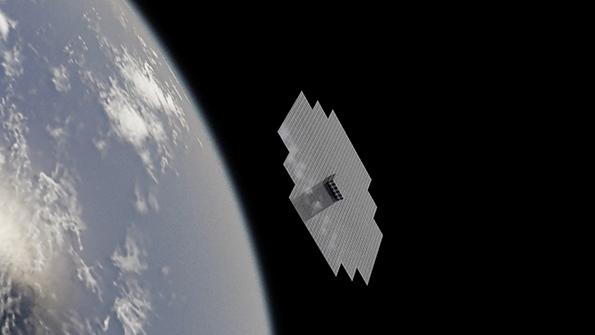衛星通信による携帯電話サービスの提供競争が過熱 | Companies Jockey To Win Satellite-Based Cellular Service Race

8月25日、米通信大手T-Mobile社がSpaceX社の低軌道通信衛星コンステレーション「Starlink」をテキストメッセージ(SMSや各種メッセージアプリを含む)の通信に利用する契約を発表したことで、衛星通信による携帯電話サービスの提供競争が過熱している。
この提携は、AST SpaceMobile社やLynk社といったスタートアップ企業が、今後開発される衛星コンステレーションを用いて携帯電話サービスを提供するために、世界中のモバイルネットワーク事業者と周波数の割当に関する契約を締結したことに続くものだ。また、今回の合意は、Apple社と衛星通信会社Globalstar社が、iPhoneの将来モデルに衛星ベースの通信機能を搭載するために提携すると噂されていたことに先立つものである。
新進の衛星通信会社は、宇宙ベースの携帯電話サービスにより圏外エリアを消滅させ、遠隔地や貧困層の人々にも無線通信を提供し、世界中で緊急援助サービスやIoT機器の活用を可能にすることを想定している。
Lynk社のCEO・ Charles Miller氏は「この技術は、何十億もの人々が持つ問題を解決するものだ。衛星や宇宙関連のマーケットの中で最大のものになるだろう」と話す。
とはいえ、衛星〜携帯電話間のサービスはまだ初期段階にあり、そのほとんどが各種テストにより技術的な制約の克服を進めている段階だ。また、世界中の規制当局も、宇宙を利用した携帯電話サービスにはまだ認可を与えていない。
そんな中、Lync社は4月に打ち上げ、現在試験を進めている「Tower 1」衛星が、年内に宇宙からの携帯電話サービスを提供する最初の衛星になると主張している。極低軌道にあるこの1基の衛星は、遅延を伴う形でのテキストメッセージの送受信用途に限定される見込みだ。
一方、SpaceX社は第2世代のStarlink衛星群を使って、アメリカ本土・ハワイ・アラスカの一部・プエルトリコ・アメリカ領海内(T-Mobile社の地上ネットワーク圏外)でのテキストメッセージ利用を実現しようとしている。
創業者のElon Musk氏は8月25日、テキサス州ボカチカにある同社施設「Starbase」で行われた提携発表イベントで、来年に計画されているStarlink V2の打ち上げ後、同年末までに一部の地域でベータプログラムを開始し、このサービスを提供していく方針だと述べた。SMSやMMSに加え、このプログラムに参加するメッセージアプリを含む、テキストメッセージ機能のサポートが予定されている。
そして、Twitterには「回線速度は各セルゾーンあたり2〜4Mbpsで、テキストのやりとりや音声通話には充分だが、広帯域ではない」と投稿している。
また、これに続くTwitter投稿では、テスラ車のオーナーで、Premium Connectivityパッケージ(車載用データ通信プラン)に加入している場合、いずれStarlinkを用いた通信も可能になるだろうと述べている。
これら2社とは異なり、9月に試験衛星「BlueWalker 3」を打ち上げ予定のAST SpaceMobile社は、宇宙ベースの携帯電話サービスによる「ブロードバンド級の回線速度」の提供を目指していると、同社最高戦略責任者のScott Wisniewski氏は明らかにした。ただし、具体的な通信速度には言及していない。
また彼は「当社の衛星〜携帯電話アーキテクチャは、(地上の)携帯電話アーキテクチャに可能な限り近付けた設計をしている。これまでNokia社がVodafone社に提供してきたような基地局やソフトウェアと同等のものが、衛星に搭載されているイメージだ」と述べた。
SpaceX社やLynk社のシステムも、一般的な基地局と同じように動作するよう設計されている。しかし、衛星〜携帯電話間の通信は複雑なものだ。
Elon Musk氏は提携発表イベントの中で、「携帯電話からの極めて微弱な信号を受信するには、(衛星側に)きわめて高性能なアンテナが必要になる。800km離れた場所で発信された信号を、時速約2.7万kmで移動する衛星で受信し、さらに超高速移動によるドップラー効果を補正することの困難は、想像に難しくないだろう」と述べている。
反対に、軌道上から送信するためには、SpaceX社のStarlink V2衛星が搭載するアンテナは約25平方メートルの面積が必要になる。 AST SpaceMobile社のアンテナはさらに大きく、約64.4平方メートルになるだろう。一方、Lync社は自社が保有するデジタル信号処理技術を用いることで、わずか1平方メートルのアンテナで宇宙ベースの携帯電話サービスを実現できると主張している。
携帯電話側もまた、地球低軌道からの信号を受信するのにかかる20〜40ミリ秒の遅延を処理する、高度なソフトウェアが必要になるとWisniewskiは言う。
彼は「携帯電話では刻々と時刻の同期が行われており、中には5ミリ秒間隔でなされるものもある。我々は、特許を取得したソフトウェアを用いることで、携帯電話が直面する遅延やドップラー問題に対処できることが分かった。これにより、必要な信号を全て受け取るまで電話が待機するようになる」と説明した。
しかし、衛星〜携帯電話間の通信サービスにとって最大のハードルは、実のところ通信用の(これまで基地局との通信に開放されていた)周波数帯域を所管する規制当局にあるかもしれないと語るのは、コンサルティング会社TMF Associates社のアナリスト・Tim Farrar氏だ。
同氏は「アメリカには、どの帯域を衛星システムで使用し、どの帯域を地上波で使用するかを取り決めた周波数割当票がある。地上用に指定された周波数帯を宇宙で使えるように、ある種の特例承認をすることは可能だが、まだそのような措置は取られていない。これを実現することは、かなり大きな政策変更になるだろう」と述べた。
The race to provide cellular service from satellites is heating up after T-Mobile announced on Aug. 25 an agreement to use SpaceX’s Starlink constellation of low-Earth-orbit communications satellites for text message coverage.
The partnership follows startups such as AST SpaceMobile and Lynk, which have signed agreements with mobile network operators around the world to borrow spectrum allocation to provide space-based cellular service via future satellite constellations. The agreement also comes ahead of a rumored partnership between Apple and satellite communications company Globalstar to provide satellite-based connectivity for future versions of the iPhone.
Budding satellite companies envision space-based cellular service ending reception dead zones, extending wireless communications to remote and impoverished people, providing emergency backup service and connecting internet-of-things devices worldwide.
“[This] technology solves a problem for billions of people,” says Charles Miller, CEO of Lynk. “It’s going to become the biggest market in all satellite and space.”
Yet, satellite-to-cellular services are in their early days, with most still testing and working through technological limitations. Regulators around the world have also yet to give the go-ahead for space-based cellular service.
For its part, Lynk claims its “Tower 1” satellite, launched in April and undergoing testing, will be the first to provide cellular service from space by the end of the year. The single satellite, which is in a polar low Earth orbit, will be limited to providing text messaging on a delayed basis.
SpaceX plans to use second-generation Starlink satellites to provide text message coverage across the continental U.S., Hawaii, parts of Alaska, Puerto Rico and U.S. territorial waters—remote regions outside the signal of T-Mobile’s terrestrial network.
The service will be offered starting with a beta program in select areas by the end of 2023, after SpaceX’s planned Starlink V2 launches next year, SpaceX founder Elon Musk said Aug. 25 during an event announcing the partnership at his company’s Starbase facilities in Boca Chica, Texas. Text messaging, including SMS, MMS and participating messaging apps, will be supported.
“Connectivity will be 2-4 [Mbps] per cell zone, so [it] will work great for texting [and] voice calls, but not high bandwidth,” Musk wrote on Twitter on Aug. 25.
Tesla car owners, who subscribe to the company’s Premium Connectivity package—essentially a cellular data plan for the vehicle—will eventually be able to use the Starlink constellation for connectivity, he added in a subsequent tweet.
AST SpaceMobile, which plans to launch its BlueWalker 3 test satellite in September, is aiming to provide space-based cellular service at “broadband speeds,” says Scott Wisniewski, the company’s chief strategy officer, who declined to disclose specific data rates.
“Our satellite-to-cellular architecture is designed to mirror [terrestrial] cellular architecture as much as possible,” he says. “The equipment and software that someone like Nokia traditionally makes for Vodafone, that sits at a tower, we have some of that on our satellite.”
SpaceX and Lynk’s systems are also designed to operate much like another cell tower. Making satellite-to-cellphone communications work is complex, however.
“The [satellite] antennas have to be extremely advanced because they have to pick up a very quiet signal from your cellphone,” Musk said during the event announcing the partnership. “You can imagine that signal has to travel 500 mi. and then be caught by a satellite that’s traveling 17,000 mph, and the satellite has to compensate for the Doppler effect of moving so fast.”
To broadcast from orbit, SpaceX’s Starlink Version 2 satellite antenna will be roughly 25 m2 (270 ft.2) in area. AST SpaceMobile’s satellite antenna will be even larger, about 64.4 m2. Lynk said it can make its space-based cellular service work with a satellite antenna that is only 1 m2 in area, using its expertise in digital signal processing.
Cellphones also need clever software to handle the 20-40 millisec. of latency that comes from the time it takes to receive a signal traveling from low Earth orbit, Wisniewski says.
“There are a lot of things that are being time-synced in a cellphone every moment and some of them are [happening in] as little as 5 millisec.,” he says. “We were able to show that our patented software can manage delay and Doppler issues that the phone experiences. The phone will wait so that it can get all the signals it needs.”
Ultimately, the biggest hurdle to satellite-to-cellular service might be communications regulators that are considering the consequences of spectrum—initially granted for broadcasts from terrestrial cell towers—being used for transmission from space, says Tim Farrar, an analyst with consultancy TMF Associates.
“The U.S. has a table of frequency allocations [that] say which bands can be used on satellite systems, which bands are for terrestrial use,” he says. “Although they could grant some sort of waiver that would allow spectrum designated for terrestrial use to be used in space, they’ve not yet taken that step. It will be quite a major change in policy to do something like that.”